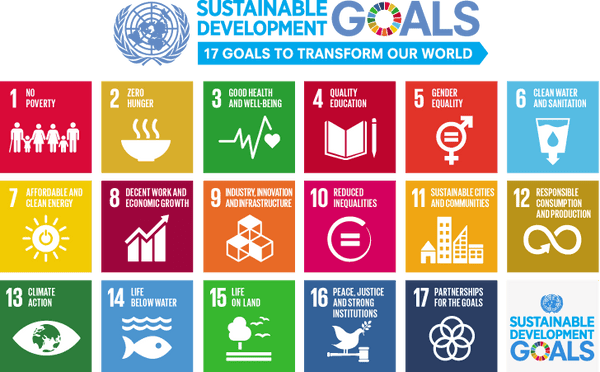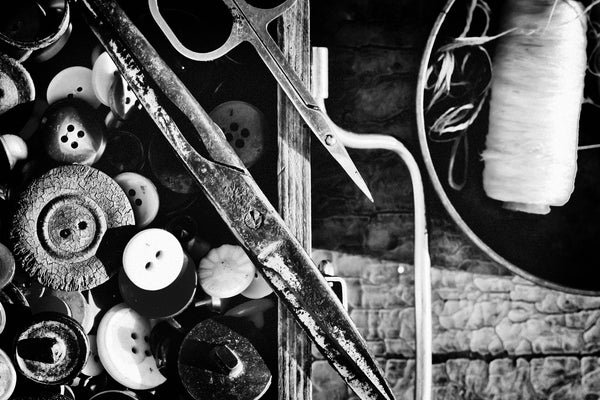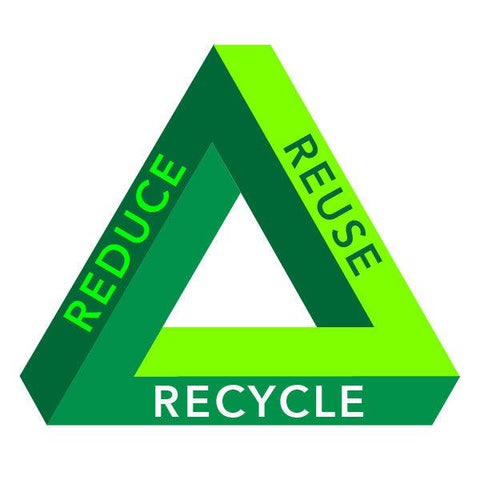ReCode is the DressCode Shirts upcycling system
Our goal with the ReCode service is to create a sustainable fashion solution, combining materials, knowledge and design skills to create new shirts from old ones.
Awareness of the issues
We are all aware of the environmental challenges. Climate change, plastic pollution and deforestation are having bigger and bigger impacts on the daily lives of everyone, everywhere on the planet. Unfortunately these terms are just a few examples that come front of mind, but the list of environment issues that we need to address is much bigger. It can feel overwhelming, we're not claiming to answer all of the issues here, but we can expand on what we've done to date, pushing ourselves to go further as we seek to minimise the impact of our activities on the planet through our sustainable manufacturing systems, things like Made On Demand and ReCode.
Personal principles
Individually this can feel like a heavy weight to bare. Success will come from working together as a global team. Where we each contribute, making an impact collectively, achieving the UN targets through our adoption of a more sustainable lifestyle, this includes our fashion choices.

Upcycling is an excellent way to do this, in this post we'll explore the benefits of upcycling shirts, how you can do it yourself and where we can help.
What is Upcycling?
Let’s start by defining what we are talking about. Upcycling is the process of transforming discarded or unused materials into new products. Often these second generation products are higher value - cost due to the materials and craftmanship used, but also the quality of the product and the personal connection to it's design and development. Upcycling is a form of recycling, where instead of breaking down the materials, they are repurposed and given a new life.
The benefits of Upcycling Fashion
- Reducing waste
By far the biggest benefit of upcycling clothing is the reduction in waste. The fashion industry is notorious for its waste, with millions of tons of textiles ending up in landfill every year. Through upcycling initiatives like ReCode, we can prevent the creating further waste and give these materials a new purpose, extending their life.
- Saving resources
Upcycling saves resources. Creating new clothes consumes significant volumes of water, energy and raw materials (which need to be grown or manufactured). Upcycling can reduce this demand on resources and help protect our planet's delicate balance.
- Promoting creativity
Upcycling is a great way to express your creativity. This is the very definitive of bespoke! You are creating unique, one-of-a-kind pieces that reflect your personal style. It’s also an opportunity to experiment with different techniques and materials. Above all, it’s a process that is an engaging and fun activity.
- Supporting local communities
Upcycling can also support local communities. If you use materials sourced from local craft makers or businesses, you are supporting the local economy and skills in your area. You are also embracing and promoting sustainable practices.
- Saving money
Finally, upcycling can save you money. Instead of buying new clothes, you can repurpose old ones, reducing your overall spend. Upcycling also allows you to create unique pieces that you can't find in stores, so you could say that what you create is ‘priceless’ and certainly much more personal, making your wardrobe more meaningful and giving you a real connection to the items within it.

Upcycling shirt trends
Like everything, there are trends in Upcycling from around the world. As a shirt company, we are going to focus on what’s happening in our sphere. So let’s take a closer look…
1 Patchwork Shirts
Patchwork shirts are a popular approach to upcycling. This style involves taking different fabrics and piecing them together to create a unique, eclectic look. Patchwork shirts can be made using a wide range of materials - old shirts, jeans or even curtains, making them an affordable and sustainable option. One word of warning, if you don’t wear anything under your shirt, be sure to use soft, smooth and breathable materials.
2 Tie-Dye Shirts
Tie-dye feels like something that has never really gone away, like it’s always there in one form or another and this style remains a popular when upcycling shirts. The process involves using dyes to create patterns. There’s a lot of fun to be had with Tie-dye, it’s random and doesn’t require a lot of skill. Though if you’re unsure about tie-dye upcycling your clothes there are lots of tutorials online to help you get started.
3 Embroidered Shirts
If your handy with a sewing machine or even a needle and thread, embroidery is a great way to add a personal touch to an old shirt. Embroidery can be as simple or complex as you want to make it. We’re very much of the ‘keep it simple’ train of thought, where less is more, this can be done by hand. If you want something more complicated or intricate we’d suggest using a machine and there are 1000’s of tutorials online to help guide you.
4 Applique Shirts
Applique is a technique that involves attaching one piece of fabric to another to create a design, it's a great way to add a unique touch to your shirt, with details like a pocket or elbow patch.

How to upcycle shirts
We have already covered the benefits of upcycling and some popular trends, let's look at how you can upcycle a shirt yourself. The first step in upcycling…
Collecting materials, vintage and second-hand
When it comes to choosing source materials for upcycling shirts, there are a few things to keep in mind. One of the easiest ways to upcycle shirts is to use second-hand clothes. This could be clothes that you no longer wear or clothes that you find at a charity shop or market, even a haberdashery - there are always ends of rolls for sale.
It could also be clothes that you have received from friends and family, or clothes that no longer fit. Using these in your upcycled shirt not only reduces waste but also saves the resources involved in the production of new garments as well.
Upcycled Fabric
Another option is to purchase upcycled fabrics. These fabrics can be found easily online and there are increasingly more places to go and explore old clothes and linens. Upcycled fabric is a good way to save resources and support others who are already embracing the upcycling and re-use movement.
Sustainable materials
If you do choose to use new materials, consider using sustainable materials such as organic cotton, hemp or linen. These materials are grown without harmful pesticides and use less water. FYI - we have previously used organic cotton.
Tencel, which is made from eucalyptus trees, is a sustainable option as it uses less water and energy than conventional production. In fact it's won many awards for its sustainability. Again, if you’ve followed our work, you’ll know that we love Tencel and advocate using it.
By choosing sustainable source material and production technique, you are making a positive impact on both the environment and your wardrobe.
Get creative
Without a doubt the best bit (for us). Once you have your materials, your ideas and the shirt that you want to upcycle, it’s time to experiment. Try different combinations, lay things out, look at what appeals to you - colours, textures and how they sit next to one another, the composition. It’s also worth putting the clothes that you’re likely to wear with the upcycled shirt on the floor too, unless you have a mannequin, really get involved and have fun assembling your new shirt.
ReCode
If this fills you with dread, don’t worry we can help. Simply gather your material together, along with the existing shirt or shirts and send them to us. We’ll then begin our ReCode process.
Case study – James’ patchwork shirts
James was one of the first people outside the DressCode team to stress test the CashCuff concept – see our earlier blog for full details. James is a cyber security expert, heading up the team at www.bores.com
When James contacted us, he had been collecting materials from his travels for some time. These were pieces of material that really meant things to him. He’d always had the ambition to create a shirt from them but he had hit a brick wall, no-one was able to help him realise his vision for shirts made from these materials.

I tend not to speak directly with James, we usually chat on Twitter, on this occasion that really helped us to explore the options quickly. James asked me if upcycling material into a shirt was something that we could do. It’s actually something that we have been doing from day one for customers, but it’s certainly become more popular over time.
I went back to James and said, “Sure, we can help.” and arranged for the material to come to DressCode HQ. Once we had got our hands on the materials we could ook at the quality and the size of each piece before starting to explore how this could work. What was it that James wanted? What limitations were there from the materials? And what kind of visual could we create?

We created 2 shirts for James, his preference was for short sleeves, we knew his size from the CashCuff testing and got to work creating the patchwork shirts. We experimented with the colours and patterns before finalising the designs and moving into cutting and sewing.
When I shared the images of the finished shirts with James he was taken a back, this was exactly what he wanted! We arranged to post the shirts to him and when he received them he was over the moon.
“These are without a doubt the best shirts that I have ever had.”
Hearing that is music to our ears. We are extremely proud to say that we hear those kind of comments a lot from our customers, but with the ReCode products the satisfaction is even greater, knowing that we are enhancing someone’s shirt, reducing the consumption of the planets resources and giving something back feels fantastic.
As with all of our shirts, for every ReCode shirt that we produce, we plant a tree, putting something back into nature to help sequest carbon and reduce climate change.

Behind the scenes, how does the ReCode programme work?
The ReCode programme uses our current best practice model, this includes:-
Paying for skills
We have always paid the people that we work with a wage that reflects their skills, craft and knowledge. We want everyone involved in the process to feel good about what they are doing, that only works when you recognise what each person brings to the table, and pay them for what they are doing, because happy people make better things – fact!
Renewable energy
We use 2 forms of renewable energy. First we self-generate, using Photovoltaic panels, secondly we buy any additional energy from a certified, ‘renewable energy’ supplier.
Responsible sourcing
If we need to source additional material to complete your request we will always endeavour to use existing off-cuts and roll ends. Should there be no other option, and a genuine need for something new, we can create it using digital print processes to minimise the consumption of resources.
Green transportation
We have embraced slow-fashion, so we avoid using overnight couriers and won’t use any carrier who doesn’t have a recognised ESG programme. This does increase the time involved in the despatch process, but we think it’s worth it and we know that our clients appreciate it too.
Let's ReCode your shirts
For more information about the ReCode service is available here or contact us
Further information
We have covered a wide selection of environmental and sustainability areas within our blog. We also produce a Climate Code shirt, working in collaboration with the British Antarctic Survey and Professor Ed Hawkins

